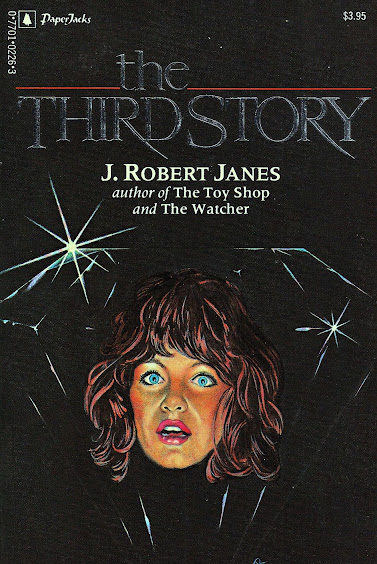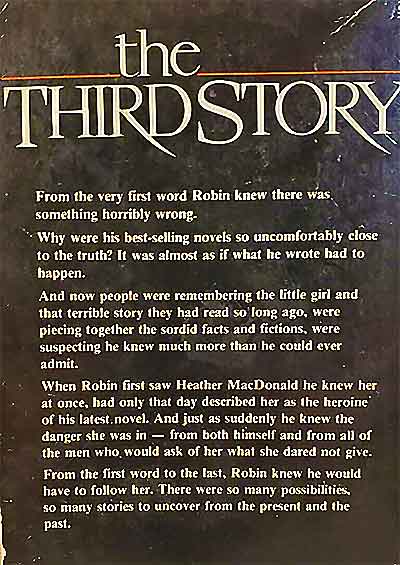 By J. ROBERT JANES (PaperJacks; 1983)
By J. ROBERT JANES (PaperJacks; 1983)
An ambitious horror novel by a prominent Canadian author that suffers, in a not-uncommon issue, from seriously trashy packaging. The author was the talented J. Robert Janes, and the publisher the mass market outfit PaperJacks, which had severely mishandled Janes’ previous novels THE TOY SHOP and THE WATCHER, and did so once again with THE THIRD STORY.
I may be wrong in calling THE THIRD STORY a horror novel…
I may be wrong in calling THE THIRD STORY a horror novel (although the packaging has no problem doing so), as it’s actually a genre-busting multi-hander that juggles thwarted longing, espionage, family secrets, a crime procedural, a very meta rumination on the act of writing fiction and (possibly) the supernatural. It’s far more, in short, than the “chilling tale of danger uncovered” promised by PaperJacks.
…it’s actually a genre-busting multi-hander that juggles thwarted longing, espionage, family secrets, a crime procedural, a very meta rumination on the act of writing fiction and (possibly) the supernatural.
Robin is a troubled novelist convinced his words can shape reality. His major obsession is with Heather, a young woman who closely resembles Wendy, a girl who went missing years earlier. Heather is, like Robin, a profoundly depressed, guilt-ridden and possibly insane individual. She’s taken a job as a small town librarian in order to mask her true occupation: international diamond smuggler. She’s also moved in with Wendy’s elderly mother, who believes Heather is her deceased daughter. Most everyone around them thinks Heather is deliberately exploiting the old woman for financial gain, but Heather’s true motives are far more complex—indeed, she may actually be Wendy.
…an apt distillation of the baroque descriptions that power this novel, which are suggestive rather than concrete.
 As for Robin, he believes his current manuscript is dictating Heather’s life, just as one of his previous books did Wendy’s. His wife Angela, meanwhile, comes to believe Robin may be using the fictional angle as an excuse to cover up his own criminal proclivities, and their marriage goes into a death spiral because of it.
As for Robin, he believes his current manuscript is dictating Heather’s life, just as one of his previous books did Wendy’s. His wife Angela, meanwhile, comes to believe Robin may be using the fictional angle as an excuse to cover up his own criminal proclivities, and their marriage goes into a death spiral because of it.
J. Robert Janes himself is another evident presence in the novel. The thrillers Robin writes seem quite similar to those turned out by Janes, whose use of language is very much akin to an analysis Angela makes of Robin’s prose: “Robin used bits of description as a painter uses colors, not so much to detail the subject as suggest things, to get the reader’s mind working.” That’s an apt distillation of the baroque descriptions that power this novel, which are suggestive rather than concrete.
The narrative may grow a bit overcomplicated in the final third, with a heretofore unknown protagonist being introduced and some untold secrets (such as a clandestine abortion) glommed onto an already overburdened story. Janes’ artful and elliptical prose, though, keeps the reader hooked, conveying a sense of mystery so profound that a fully cogent solution is probably impossible.
